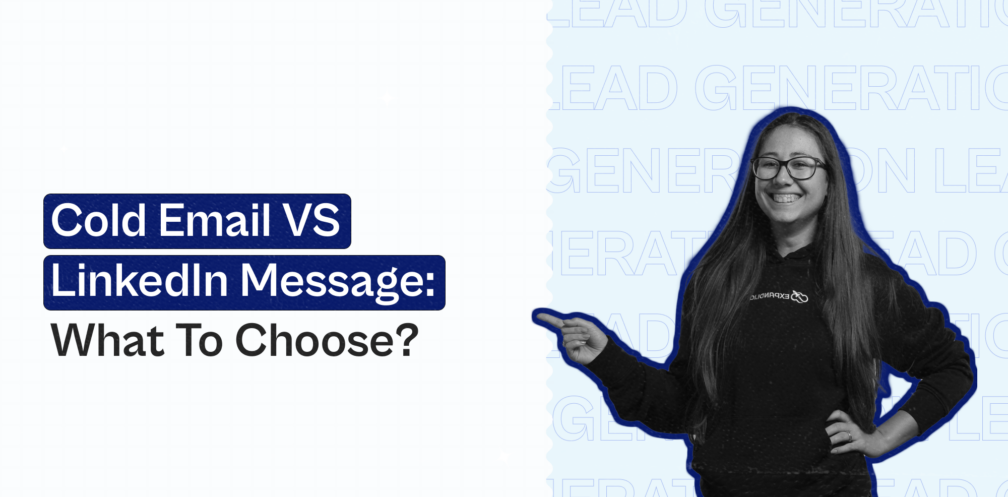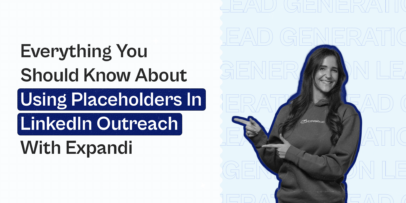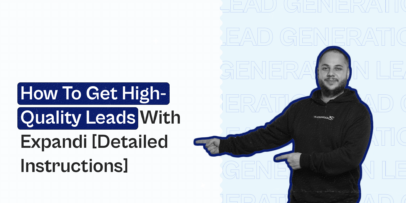Cold Email VS LinkedIn Message: What To Choose?

Wondering what is the best channel for outbound sales?
You don’t need to be an outreach expert to know that cold email and LinkedIn messages are probably one of the best ways to reach your prospects.
Especially if you work in B2B.
However, if you’re wondering whether you should use email vs LinkedIn messaging – things aren’t so simple.
One isn’t necessarily better than the other.
So, when comparing cold email VS LinkedIn, we’ll be looking at the following factors:
- Ease of getting started.
- Reply rate.
- Follow-ups.
- Automation.
- Velocity.
- Deliverability.
- Cost.
- Scale.
If you’re looking for a short answer though, here’s what you need to know:
Understanding email marketing vs LinkedIn isn’t so simple. Both of them have their own pros and cons and excel at different things.
If you want to make sure you’re getting the most out of your outreach in 2024, we recommend using both!
To learn how to do just that, as well as the pros and cons of email vs LinkedIn, and more, be sure to keep reading. Here’s what you’ll learn:
- Cold email outreach: an overview of what you need to know (pros and cons)
- LinkedIn messaging and outreach: an overview of what you need to know (pros and cons)
- How and why combine both email and LinkedIn for maximum results.

PS – Looking for more sales outreach content and proven strategies?
Be sure to join our private group called The LinkedIn Outreach Family for more tips on automation, outreach, proven templates and strategies, and more.
Now, let’s get started.
Cold Email Outreach: An Overview
Email outreach has been around forever. So, it’s safe to say they’re here to stay.
But are emails better than LinkedIn?
Let’s take a look.
Typically, a cold email consists of the following elements:
- Subject line – The purpose of which is to get your prospects to click on your email. This is your first impression. If you’re sending a cold email, your prospect doesn’t know you. So, this should be short and direct to stand out.
- Body text – This is the section for your pitch. Make sure your message is relevant to the recipient, be clear in what you ask, and personalize accordingly.
- Follow-ups – Most people give up after the initial message. In reality, you need to send a few follow-ups if you want someone to reply.
Cold email is so simple, right?
Well, not quite.
Because, when sending a cold email outreach campaign for lead generation, the steps typically include:
- Buying a new domain – First, you need to buy a new domain and use that for outreach. In case the domain gets burned or blacklisted, your main domain won’t be affected.
- Email authentication – To increase email deliverability, you need to authenticate DKIM, SPF, and DMARC. This signals to Google that your email is legit.
- Warming up your email – Then, you should use an email warm-up tool before you do outreach. This shows you’re a real person and not a spammer. Thankfully there are email tools that help with this. Though, the process can take up to 3-4 weeks.
- Email KPIs – When sending emails, you need to track your open rate, reply rate, and meetings booked rate. Of course, you don’t have to calculate them manually, as your email tool will just tell you the results, but you should still have a baseline of what to aim for in terms of KPIs.
- Optimization and analytics – Finally, you need to make well-informed decisions based on data. For example, if you have a low open rate, you need to tweak your subject line. In case of a low reply rate, your pitch angle or CTA. And in case you’re not booking enough meetings, you should experiment with changing your offer or target audience.
With this in mind, let’s now take a look at the pros and cons of cold email outreach.
Cold email advantages
A cold email is usually sent to a prospect with whom you have no prior relationship, with the purpose of introducing yourself and your business.
Whether you’re looking to generate leads, increase your sales, or some other objective, cold emails offer a number of advantages, such as:
- Cost-effectiveness – Cold emails are relatively cheap to get started with. You need a new domain, which can be under $10 a year, and an email marketing tool (to warm up your email and start sending outreach campaigns). The latter depends on your needs. But typically, you can get an email outreach tool for $30-$100 a month.
- Scalability – To scale the number of emails you’re sending, you just need a new domain to warm up and add inside your email tool.
- Personalization – You can tailor cold emails to your target audience’s needs, interests, pain points, and more. Additionally, you can insert personalization tags (first name, company name, or something unique for each prospect), to make your emails feel authentic.
Another option is to also introduce cold calling into your campaigns.
See our thoughts on the topic here.
Cold email disadvantages
What about the drawbacks of sending cold emails?
Here are a few:
- Easy to ignore – One of email’s big pros is its downside as well. Because of how easy it is to get started with email outreach, it’s also common for people’s inboxes to be overflown with cold emails. You’re competing for your prospect’s attention along with hundreds of other people.
- Lower engagement – Email has typically lower engagement (especially when compared to LinkedIn), because the prospect doesn’t know you. With LinkedIn, for example, the prospect can go back to your profile to learn more about what you do. This isn’t the case with email.
- Legal issues – Cold emails must comply with anti-spam laws, such as CAN-SPAM Act and GDPR. While cold email is simply illegal in Germany.
Important cold email stats to keep in mind
Now, to put things into perspective, let’s take a look at some important statistics to keep in mind when it comes to cold email.
Note that we’ll do the same for LinkedIn below as well.
So, if you’re wondering how cold email vs LinkedIn messaging compare in terms of data, this section is for you.
Before we cover that though, there’s one other important thing to keep in mind.
Let’s say you launched a cold email campaign and got an average open rate of 70%.
Is that a good thing or a bad thing?
It’s hard to say. Because you also need to take a look at other, important email metrics. Such as your reply rate.
In other words, a high open rate doesn’t mean much if no one’s replying. And a high reply rate also doesn’t mean much if no one’s booking meetings or you’re not generating the desired results.
That said, here are the stats on cold email.
- According to Close, you should be aiming for a minimum of 30% open rate.
- A study by Backlinko says that most outreach messages are ignored and only 8.5% of outreach emails receive a response. And emails with a personalized message body have a 32.7% better response rate than those not personalized.
- 44% of salespeople give up after just one follow-up. Meanwhile, you increase your average reply rate to around 13% if you do follow-up.
- The main problem people struggle with when it comes to cold email is personalizing each message at scale and targeting the right people.
All this said, email is by no means a bad platform.
But considering the fact that most people receive up to 100-120 emails per day, it’s getting harder and harder to stand out in your prospect’s inbox. Even with an effective subject line.
Now, let’s take a look at how LinkedIn stands vs email marketing.
LinkedIn Messaging And Outreach: An Overview
The crux of LinkedIn messaging and outreach is that everything happens inside the platform.
You find your target audience there, send connection requests, send messages and follow-ups, create content for them, and more.
If you work in B2B, this is particularly important because 96% of B2B marketers use LinkedIn to distribute content and engage with their leads.

And with over 65M+ business decision-makers on the platform, you’re guaranteed to find your audience there for outreach.
Now, compared to cold email, there are a number of different ways to generate leads on LinkedIn.
Here’s an overview:
- You can find your target audience with LinkedIn searches, scrape the list and automate your outreach with LinkedIn automation tools like Expandi. This is by far the most popular method to generate leads.
- You can create content based on your content strategy to attract leads inbound and grow your audience. This is essentially to demonstrate your expertise and convince leads to work with you when they consume your posts.
- You can network in LinkedIn groups to grow your network and contacts.
- You can send LinkedIn InMails to cut through the noise and stand out in your audience’s inbox.
- And more.
So, as you might have noticed, one big advantage LinkedIn has vs email is that there are many more ways to generate leads here.
Additionally, you can slowly grow your audience and network, without jumping into a pitch straightway. Then, once someone is ready to work with you, they can reach out to you later.
With email, you’re almost always pitching yourself if you want to book meetings. Some people don’t like receiving cold pitches.
LinkedIn messaging advantages
No doubt LinkedIn is an important place to be if you want to generate leads and grow your audience.
Here are some of the main advantages LinkedIn messaging and outreach offer:
- Targeted outreach – LinkedIn lets you be highly targeted in your outreach efforts as you can search for prospects based on specific criteria such as location, industry, job title, and more.
- Built-in network: LinkedIn is a network-driven platform. When you connect with someone, you gain access to their network, potentially expanding your reach and opening new doors.
- No deliverability issues: Unlike cold email, LinkedIn messages are delivered directly to the recipient’s inbox, reducing the chances of your message being marked as spam.
- Professional branding and audience growing: Active engagement on LinkedIn helps build your professional brand and reputation over time. By sharing valuable content, you can connect with industry peers and position yourself as an expert in your field.
- Automation and integration: This is possible with email as well, but you have more options when it comes to automating LinkedIn outreach. Because this is based on certain conditions and sequences you can set up for your outreach.
LinkedIn messaging disadvantages
Of course, LinkedIn is not without its drawbacks. Which include:
- Platform restrictions: Currently LinkedIn has a limit of sending around 100 connection requests per week. Additionally, LinkedIn can sometimes limit your searches if you’re using the free version of the platform.
- High budget: If you want to take your LinkedIn messaging to the next level, you’ll want to invest in LinkedIn Sales Navigator for a more targeted outreach (which can cost around $65.99/mo) or LinkedIn InMails (around $79.99/mo for 50 credits) to cut through the noise.
Note that while that may seem expensive, if you use Sales Navigator to land at least 1 client a month (which is totally doable), the cost will pay for itself.
Alternatively, you can start with Expandi (7-day free trial and $99/mo after) to automate your LinkedIn lead generation and outreach, which you can also use with the free LinkedIn version.
This will also pay for itself since you’re using it to get new paying clients.
Important LinkedIn stats to keep in mind
It’s harder to quantify LinkedIn average statistics, because there are far too many variables to consider. Such as your templates, target audience, offer, campaign objective, sequence, and more.
Instead, let’s take a look at what’s possible with LinkedIn outreach.
- According to LinkedIn, InMails have a 10-25% reply rate when it comes to soliciting a response from a potential client, 300% higher than emails with the same content.
- Using dynamic GIFs and personalized outreach for a lead generation campaign, we achieved a 55% reply rate.
- Salescout landed 6 new demos and $250k in the pipeline in just 3 weeks.
- 72% acceptance rate with our personalization outreach.
All this is based on the idea of omnichannel outreach (combining emails, LinkedIn, and InMails).
What about InMails and LinkedIn automation?
If you’re looking to generate leads, InMails and LinkedIn automation can be of huge help when it comes to the platform.
With InMails, you can contact LinkedIn users who are not in your network directly. Which eliminates the need for sending a connection request in the first place.
If you have a well-defined customer persona, you can use InMails to contact decision-makers directly.
Alternatively, you can send a connection request first, and if they haven’t replied after some time, send an InMail with a convincing subject line or email.
Then, with LinkedIn automation tools you can streamline your outreach process even more by setting up outreach sequences with your target audience.
This is based on Actions and Conditions you can set up for your LinkedIn outreach.
Actions include:
- Visit profile.
- Follow profile.
- Follow company.
- Skill endorsement.
- Connection request.
- Followup message.
- Open InMail.
- Email.
- Like a post.
Conditions include:
- Custom condition – For example, To continue when a person is not connected, check “If connected” and toggle the “If not” slide. If nothing is checked, it will skip this specific condition and will not be taken into account. It is recommended to have at minimal one setting per endpoint; otherwise, it will automatically pass.
- If connected.
- If followed you.
- If visited your profile.
- If email opened.
- Email bounced.
- Email clicked.
- Email exists.
- If Open InMail.
- If post liked.
While email has limited automation, you can set up flows that take into consideration every possible outcome for your lead generation campaign this way.
Here’s an example of an outreach sequence template.

Looks complex?
Don’t worry. You can just grab our pre-made outreach sequence steps and templates below.
How And Why Combine Email And LinkedIn For Maximum Results
Now, the question shouldn’t be “cold email vs LinkedIn“.
Instead, it should be cold email AND LinkedIn.
This way, you get the best of both world benefits such as:
- Higher number of outbound messages – You can send only around 100 connection requests per week with LinkedIn. But by introducing InMails and emails into the campaign, you can send well over 250+ messages per week.
- Full automation – Through tools like Expandi, you can set up outreach campaigns that use LinkedIn AND email messages, all from one place. This way, you don’t have to switch across 3 different tools. You can also see the results and analytics for each campaign (which includes LinkedIn and emails) in one place, no more switching apps.
- More likely to stand out – It’s simple. Instead of sticking to just one platform, by combining both, your prospects are more likely to reply and get back to you. Some people prefer LinkedIn, while others prefer email. This way, you’re targeting both audiences.
How to combine cold email and LinkedIn messaging for omnichannel outreach
The key to combining them is through tools like Expandi.
It’s simpler than you might think too.
You can set up your first campaign in under 15 minutes with a free trial. Then, launch your campaign and start generating real leads in under 24 hours (all while still with the free trial), using our proven templates and outreach sequence steps.
For this, you need:
- Defined target audience, which you can either scrape automatically or export through a spreadsheet or LinkedIn search results. In Expandi, you can add an audience 8 different ways.
- A campaign type (10 types of cold outreach campaigns possible within Expandi). But you can use Campaign Builder to gain full control over every step of your outreach.
- And outreach templates. You can use ours to start with or A/B test your own text.
Now, let’s take a look at how this works with a outreach campaign example you can set up in real time.
- Grab the free, 7-day Expandi trial.
- Click Search in Expandi.
- Then, click on Add new search.
- From there, you can select few different search types, based on your campaign objective and who you want to reach. In this example, we’re going to target members in a LinkedIn group, so, you’d select Group Search.
- Enter a search name and paste the URL of a LinkedIn group you want to target.
From there, Expandi will export its members.

Then, you can either export the list as a spreadsheet file to qualify and disqualify leads or continue as is. See our guide on building a prospect list for more info on managing leads.
Then, you have to add an outreach campaign to contact those leads with LinkedIn and email.
- Click on Campaigns, press Add Campaign, and select Campaign Builder (this one lets you set up custom sequence and steps with full control).
- Select a campaign name, click Next, and Create without template.
- Then, you have to add steps and templates.
Here’s an example:

What about the templates?
Check out our full guide on account-based marketing for a detailed overview of each step.
Where To Go From Here
So, to recap, it’s not “cold email vs LinkedIn”. It’s cold email AND LinkedIn.
If you HAD to choose one platform though, it’d probably be better to get started with LinkedIn first. And then, introduce email.
Both of these platforms have their own advantages and disadvantages though.
However, with LinkedIn, as you generate leads, you grow your network and audience. Then, by creating content as well, you start to position yourself as an expert in your niche. Which makes it more likely for other people to connect and work with you.
Plus, LinkedIn automation is much more powerful as you control all the steps, sequences, conditions, and actions.
With email, meanwhile, someone would have to go out of their way to go back to your website and learn more about what you do.
Now, ready to start automating your email and LinkedIn messaging outbound campaigns?
Get started with a free, 7-day Expandi trial now and connect your email provider for free as well!
You’ve made it all the way down here, take the final step


